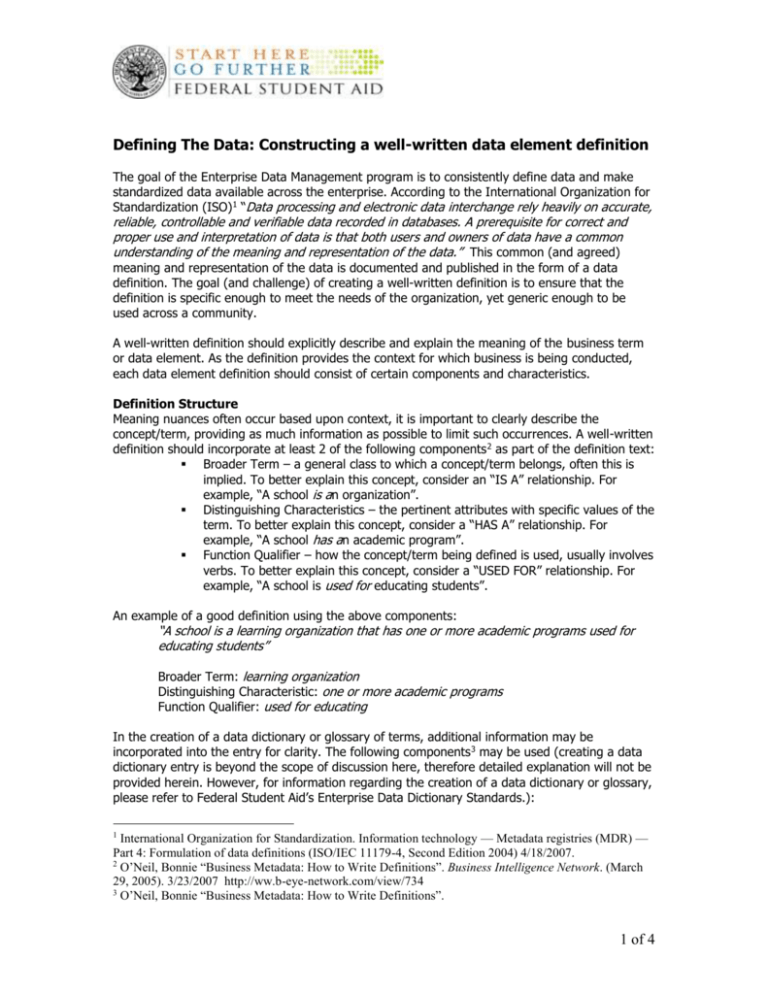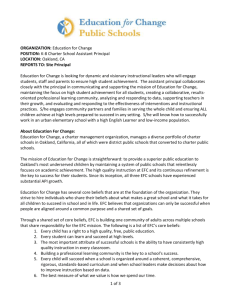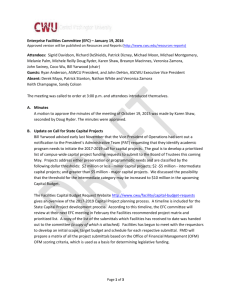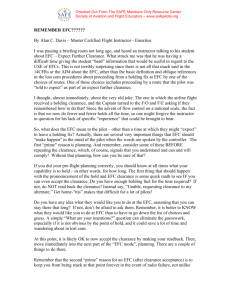Defining The Data: Constructing a well
advertisement

Defining The Data: Constructing a well-written data element definition The goal of the Enterprise Data Management program is to consistently define data and make standardized data available across the enterprise. According to the International Organization for Standardization (ISO)1 “Data processing and electronic data interchange rely heavily on accurate, reliable, controllable and verifiable data recorded in databases. A prerequisite for correct and proper use and interpretation of data is that both users and owners of data have a common understanding of the meaning and representation of the data.” This common (and agreed) meaning and representation of the data is documented and published in the form of a data definition. The goal (and challenge) of creating a well-written definition is to ensure that the definition is specific enough to meet the needs of the organization, yet generic enough to be used across a community. A well-written definition should explicitly describe and explain the meaning of the business term or data element. As the definition provides the context for which business is being conducted, each data element definition should consist of certain components and characteristics. Definition Structure Meaning nuances often occur based upon context, it is important to clearly describe the concept/term, providing as much information as possible to limit such occurrences. A well-written definition should incorporate at least 2 of the following components 2 as part of the definition text: Broader Term – a general class to which a concept/term belongs, often this is implied. To better explain this concept, consider an “IS A” relationship. For example, “A school is an organization”. Distinguishing Characteristics – the pertinent attributes with specific values of the term. To better explain this concept, consider a “HAS A” relationship. For example, “A school has an academic program”. Function Qualifier – how the concept/term being defined is used, usually involves verbs. To better explain this concept, consider a “USED FOR” relationship. For example, “A school is used for educating students”. An example of a good definition using the above components: “A school is a learning organization that has one or more academic programs used for educating students” Broader Term: learning organization Distinguishing Characteristic: one or more academic programs Function Qualifier: used for educating In the creation of a data dictionary or glossary of terms, additional information may be incorporated into the entry for clarity. The following components 3 may be used (creating a data dictionary entry is beyond the scope of discussion here, therefore detailed explanation will not be provided herein. However, for information regarding the creation of a data dictionary or glossary, please refer to Federal Student Aid’s Enterprise Data Dictionary Standards.): International Organization for Standardization. Information technology — Metadata registries (MDR) — Part 4: Formulation of data definitions (ISO/IEC 11179-4, Second Edition 2004) 4/18/2007. 2 O’Neil, Bonnie “Business Metadata: How to Write Definitions”. Business Intelligence Network. (March 29, 2005). 3/23/2007 http://ww.b-eye-network.com/view/734 3 O’Neil, Bonnie “Business Metadata: How to Write Definitions”. 1 1 of 4 Name – the name of the term being defined Narrower Term – the classes beneath/within (or belonging to) the term being defined Related Term – a term that has relevance to the concept/term being defined but not a synonym Synonyms – terms that mean nearly the same as the concept/term being defined. Examples and usage – an instance of the concept/term as it is seen in everyday life. Source – where the definition of the concept/term came from (originated). Replaced By – a newer term, that has a similar meaning as the concept/term being defined, which would indicate the term being defined is not in common usage. This can also be noted as a Synonym but may be helpful in the case of migration or reverse engineering. Approval – information about when the concept/term definition was approved, by whom, etc. Definition Requirements Understanding that the context in which the data is used is a key factor in defining data elements, generally, when composing a data element definition, each definition should have the following characteristics:4 Unique - A definition should be unique and distinguishable from every other data element definition. EXAMPLE: “Closure Date” Poor Definition: The date when something closed. Good Definition: The date that the school ceases to provide educational instruction in all programs, as determined by the U.S. Secretary of Education. Clear – A data definition should be precise, concise, and unambiguous. The definition should be clear enough to allow only one possible interpretation. EXAMPLE: “Disbursement Date” Poor Definition: The date money was disbursed. Good Definition: The date money was credited to the student's account at the school or paid to the student (or borrower if a PLUS loan) directly. Singular - The data definition should be expressed in the singular. EXAMPLE: “OPEID” Poor Definition: The identification number assigned by OPE for data exchange partners. Good Definition: The unique identifier assigned by the Office of Postsecondary Education (OPE) for each data exchange partner. 4 Positive - The definition should be expressed as what it is, limit any emphasis on what it is not. EXAMPLE: “Loan Net Amount” Poor Definition: The amount that doesn’t include any fees. International Organization for Standardization. ISO/IEC 11179-4, Second Edition 2004. 4/18/2007 2 of 4 Good Definition: The total amount disbursed to the borrower after any fees or charges have been deducted. Specific Concept - The definition should include the essential meaning or primary characteristics of the concept. EXAMPLE: “Request Tracking ID” Poor Definition: The unique ID assigned to a document match and tracking request. Good Definition: The unique identifier associated with a request action that is returned to the requestor for document matching and tracking. Defined with Commonly Understood Abbreviations - The definition should only use abbreviations when necessary and the abbreviation must be commonly understood. EXAMPLE: “EFC Available Income” Poor Definition: The available income used in the EFC calculation. Good Definition: The income available for education expenses used for determining financial need based on the Expected Family Contribution (EFC). Primary Definition - The definition should not contain any embedded definitions or underlying concepts of other data elements/terms/concepts. EXAMPLE: “EFC Available Income” Poor Definition: The available income used for determining the EFC, where the EFC (expected family contribution) is calculated by subtracting the cost of attendance from the expected family contribution. Good Definition: The income available for education expenses used for determining financial need based on the Expected Family Contribution (EFC). Expressed without rationale, functional usage, domain information or procedural information – The definition should not include statements about why and how a data element is used. EXAMPLE: “Disability Condition Status Code” Poor Definition: The codes used to identify the status of a disability condition. Good Definition: A code that identifies the confirmed status of a disability condition on a student aid record. Defined without circular reasoning – The definition should not be defined in terms of another data element. EXAMPLE: “Deferment” Poor Definition: Deferment is a subtype of Aid Transaction Good Definition: The temporary postponement of payments on a loan or debt. An example of a good definition using the above components and requirements: “Forced Collection: An involuntary collection activity (Treasury Offset Program, Administrative Wage Garnishment, Litigation) performed by Federal Student Aid to collect repayment of a defaulted loan after all other methods, efforts, and attempts to collect have been exhausted. 3 of 4 Components Usage Name: Forced Collection Broader Term: involuntary collection activity Function Qualifier: to collect repayment of a defaulted loan Optional Components Usage: Narrower Term: Treasury Offset Program, Administrative Wage Garnishment, Litigation Requirements Usage Singular: ”activity” refers to a single instance of forced collection Positive: ”to collect” refers to what forced collection is intended for as opposed to what it’s not intended for. Specific Concept: ”involuntary collection activity to collect repayment of a defaulted loan” is the primary concept of Forced collection. 4 of 4











